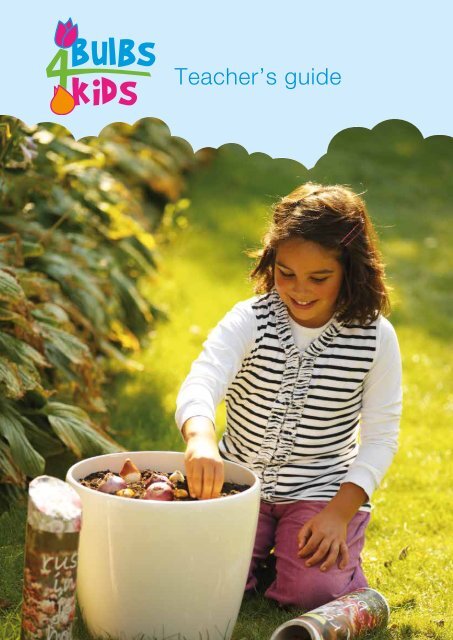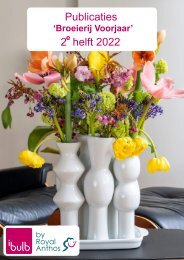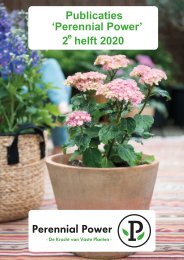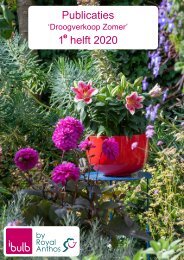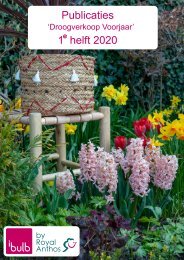You also want an ePaper? Increase the reach of your titles
YUMPU automatically turns print PDFs into web optimized ePapers that Google loves.
Teacher’s guide
Notes<br />
www.bulbs4kids.com<br />
Teacher’s guide<br />
Bulbs4Kids<br />
This document was made for teachers participating in the Bulbs4Kids campaign.<br />
It contains all kinds of information about flower bulbs and is intended to serve as<br />
a teacher’s guide for lessons about this subject.<br />
Flower bulb workbooks<br />
The Bulbs4Kids kit includes workbooks that can be used during classroom<br />
lessons. To learn more about flower bulbs, every student will receive his/her<br />
own workbook that contains stories about flower bulbs through the seasons<br />
as well as information about the history of flower bulbs. Also included are craft<br />
and photographic assignments that can be done individually or with the class.<br />
Introduction<br />
When you think of flower bulbs, you might immediately think of those<br />
beautifully colored tulip fields in the Dutch bulb-growing region between<br />
Leiden and Haarlem. But did you know that tulips aren’t the only beautiful<br />
flowers that come from bulbs? And that the traditional bulb-growing region<br />
isn’t the only place where bulbs are produced: they are also grown in the<br />
northern part of the Province of North Holland. Time to immerse yourself in<br />
the world of flower bulbs! Have fun!<br />
Teacher’s guide www.bulbs4kids.com<br />
3
Flower bulbs: a famous product<br />
What do you know about the Netherlands? Maybe not a whole lot, but you can probably name three things: windmills,<br />
wooden shoes and flower bulbs! Oddly enough, though, this list doesn’t reflect reality. Many windmills have disappeared<br />
over the years, so there aren’t that many left. And wooden shoes? Who still wears wooden shoes? Almost nobody, right?<br />
It’s only the flower bulbs that can really be associated with the Netherlands of today. And that’s been true for centuries.<br />
You can see them everywhere, all year through. In the winter, you see them inside on window sills. For the rest of the year,<br />
they bloom outside in gardens and parks where they’ve simply been planted in the ground or in large planters. And then there<br />
are the flower bulb fields. Thousands and thousands of bulbs in bloom as far as the eye can see. Many people earn their living<br />
from the trade in flower bulbs. They are sold to people all over the world. So it’s no exaggeration to say that Dutch flower bulbs<br />
are a famous product!<br />
Flower bulbs grow very differently. They are the real early birds. The way they grow is almost magical. One day, you see their<br />
shoots coming up and before you know it, the flower buds are popping open. Suddenly, after a cold dark winter, the garden<br />
is bursting with color. And now you know how this can happen. All the food needed to grow was already inside the bulb.<br />
Besides that, flower bulbs need very little sunshine. That’s why they have a big jump on other plants in the garden.<br />
Of all the flower bulbs grown in the Netherlands, hardly any are really native - or indigenous as we say - to the Netherlands.<br />
Originally, almost all of these flower bulbs come from regions around the Caspian Sea, the Black Sea, and the Mediterranean<br />
Sea where the summers are hot and dry and the winters are harsh and cold. Even now, it is this winter cold that many bulbs<br />
need. In fact, the colder the winter, the faster the bulbs will be in bloom. This is why we plant them in the fall. At that time, the<br />
ground is not yet too cold, so the roots begin to grow. Very slowly, the flower bulbs start to develop. Then winter begins.<br />
They stop growing. Their dormant period has begun. In the cold ground, the bulbs are waiting for warmer weather. On a<br />
certain day, that happens and the first shoots emerge above the surface. In the warm spring sunshine, the bulbs quickly<br />
produce stems, leaves and flowers.<br />
Flower bulbs - or are they corns, tubers, rhizomes or rootstocks?<br />
Most people don’t know it but what we often call “flower bulbs” could also be corms, tubers, rhizomes or rootstocks. People<br />
simply refer to all of them as bulbs. This is not so surprising, though. After all, they are often planted at the same time of year.<br />
They are all purchased as dry products in a bag or box. And true flower bulbs as well as corms, tubers, rhizomes and rootstocks<br />
all look rather alike. All of them contain food reserves that enable them to grow and bloom after being planted in the soil. A<br />
rhizome, however, has a different appearance: this is actually a thickened underground stem that usually grows horizontally.<br />
The tip of a rhizome often bends upward and forms a new plant there.<br />
Summer-flowering bulbs<br />
Most flower bulbs, such as tulips, hyacinths, daffodils and crocuses, bloom in the spring. As soon as winter ends, most plants<br />
in the garden are still bare of any leaves. They need time to display any signs of life. Very cautiously, they start putting forth a<br />
little green bud here and there.<br />
Summer-flowering bulbs<br />
Did you know that some kinds of flower bulbs bloom in the summer? We also plant these summer-flowering bulbs such as<br />
gladioli, lilies, dahlias and begonias outside - but not in the fall. Because they originally come from regions with a tropical<br />
climate, they cannot tolerate the winter cold. If we planted them in the fall, they would not come up in the spring. By then,<br />
freezing temperatures would have killed them. This is why summer bulbs are planted in the spring. That’s also when you can buy<br />
them. Many of these summer bulbs are less well known. After all, there are so many other plants on display in the garden at that<br />
time! Meanwhile, the plants that grow from flower bulbs are not as conspicuous. Many people don’t even know that these are<br />
flower bulbs!<br />
Tulips = Bulb Dahlia = Tuber Oxalis = Rhizome<br />
Teacher’s guide www.bulbs4kids.com<br />
5
History<br />
Tulips from Turkey<br />
Our most famous flower bulb is the tulip. “Tulip” comes from the word Tulipa which is Latin meaning “the flower that looks like<br />
a turban”. This might seem like a strange name but not when you know that tulips were already being grown and sold in Turkey<br />
during the Middle Ages. At that time, men there wore a turban. So now you know! And here’s something else: the Dutch tulips<br />
are descendants of the tulips that grew in Turkey. Turkey was a powerful country around 1550 when its ruler was a rich<br />
sultan: Suleiman the Magnificent. His palace gardens were bursting with the most beautiful tulips. After all, he was wealthy,<br />
and wealthy people can afford luxurious things. These things included tulips since tulips were highly regarded. It’s hard to<br />
believe now, but in those days, a single tulip was worth more than the life of a human being!<br />
An expensive gift<br />
The sultan was very protective of his tulips. Only his very special guests might sometimes receive a few bulbs as a gift.<br />
One of these famous guests was Mr. De Busbecq, a nobleman from Flanders who had been sent as an ambassador to Turkey.<br />
De Busbecq then gave the tulip bulbs to a friend of his, Carolus Clusius. Clusius, who was in charge of the herb garden<br />
belonging to the Emperor of Austria, gave the tulips a place of honor in that garden.<br />
The trade in bulbs<br />
Later, Carolus Clusius left Austria to live in the Netherlands. There, he became a professor at Leiden University and also the<br />
head of the university’s herb garden. He brought the tulips along with him and conducted all kinds of tests on them. But as<br />
beautiful and rare as they were, he refused to sell any. One night, however, some of his most beautiful tulip bulbs were stolen<br />
from the garden. These stolen bulbs, originally from Turkey, were the beginnings of the trade in bulbs in the Netherlands!<br />
Wild speculations in tulip bulbs<br />
At first, only very wealthy people could afford to buy tulips, so it was considered very high class to have tulips in your garden. The<br />
flamed and striped kinds were especially favored. So what happened then? Prices for tulip bulbs went through the roof! Many<br />
people thought this was a great way to become rich overnight. They took their chances and sometimes even sold all their<br />
possessions to buy a single bulb. Actually, this wasn’t even a bulb but a piece of paper stating that you were the new owner<br />
of a tulip bulb. You didn’t even get to see the bulb itself because it was planted somewhere else in the ground. And sometimes,<br />
there wasn’t a bulb at all because what you wanted to do with the piece of paper was to sell it to somebody else - and get a<br />
much higher price for it than what you paid yourself. After all, it was all about making a profit. People were paying ridiculously<br />
high prices for tulip bulbs.<br />
An amount equal to 1,500 dollars for a single bulb was not at all uncommon. Rare bulbs sometimes commanded a price equal to<br />
4,800 dollars in today’s money! This strange trade was called “tulipomania”.<br />
Expensive and unusual<br />
This speculation in tulips bulbs was short-lived. It lasted only from 1634 to 1637 when the government put an end to it.<br />
During this brief time, some people became fabulously rich. Others were less fortunate and lost everything they owned.<br />
Those were strange times but they generated a huge interest in bulbs, even in countries outside of the Netherlands where<br />
people love them to this very day. Even so, it would take years before flower bulbs were grown in many gardens. They<br />
remained expensive until around a hundred years ago. Even then, however, flower bulbs remained something special for<br />
many more years to come. Today, all that has changed. Flower bulbs are no longer expensive and not unusual either. What’s<br />
more, they are widely available. That’s why you now see them in almost every garden.<br />
Lilies conquer the world<br />
For a long time, tulips, daffodils and hyacinths were the most important flower bulbs. Many people think this is still so but<br />
much has changed. The tulip may still rank first in importance (almost half of all the bulb fields are planted in tulips), but now in<br />
second place are lilies followed by daffodils, hyacinths and gladioli.<br />
Teacher’s guide www.bulbs4kids.com<br />
7
The right soil for growing bulbs<br />
Where are flower bulbs cultivated?<br />
Long ago, flower bulb growers discovered that the soil right behind the dunes was perfect for this purpose. This is because<br />
bulbs require very good drainage - no wet feet for them. These sandy (geest) soils behind the dunes are just what bulbs need<br />
to thrive. Rainwater drains right through this soil. And the groundwater here is deep beneath the surface. Bulbs also prefer a<br />
chalky soil. These geest soils provide that, too. This is because this soil is so close to the sea that it contains a lot of pulverized<br />
shells. For a long time, the growers believed that they were restricted to these geest soils for growing bulbs. Although this is<br />
true for daffodils and hyacinths, they later made an important discovery. Tulips, lilies and gladioli would also thrive in light clay<br />
soils. This is why you now see flower bulb fields in many other parts of the Netherlands.<br />
The cultivation of flower bulbs<br />
When the bulb fields are in bloom, people flock to see them. For the growers themselves, the flowers are unimportant. All they<br />
want is to produce nice big flower bulbs. That’s what it’s all about. The bigger the flower bulbs, the more money the grower will<br />
make. So it’s no wonder that growers do everything they can to give their flower bulbs everything they want. That starts with<br />
preparing the soil. On geest soils, the groundwater is deep beneath the surface so the soil can be plowed to a great depth.<br />
This provides the flower bulbs with fresh soil again and again. But they need more than this. They also need fertilizer because<br />
the soil behind the dunes is not rich in nutrients. For this reason, growers add the fertilizer or compost that the bulbs need to get<br />
extra big and fat. Both plowing and fertilizing are thus important. This soil preparation has to be done before the bulbs are<br />
planted. This happens in October. The growers use machines for this. Afterward, the fields are covered with straw or reeds. This<br />
protects the bulbs from the worst of the winter cold. The mulch also keeps the sand from blowing away.<br />
Spring is in the air!<br />
Towards the end of winter, the layer of straw is removed. This is when you can start to see the first green shoots emerging from<br />
the soil. Day by day, temperatures rise. This triggers the plants to grow faster and faster. As soon as the bulbs produce flowers,<br />
the flowers are cut off (”beheaded”). What you see then are piles of flowers next to the fields. What a waste of beautiful flowers<br />
you might think. But the grower has to do this. If he left the flowers on the stems, they would use up all the food that the plant<br />
would produce. Then, the bulbs would remain small, and he couldn’t sell small bulbs.<br />
Harvest<br />
After the flowers are removed, all that are left in the fields are stems and leaves. These parts of the plant produce the food for<br />
the bulb to grow. Once the plants turn yellow, the flower bulbs have absorbed enough food. After this happens - between around<br />
the middle of June and early August - the bulbs are removed from the soil. This is called “lifting”. After lifting, the bulbs are dried and<br />
cleaned. The young bulblets are also removed from the large bulbs. We call this cleaning “peeling”. The large bulbs are sold. The<br />
little ones go back into the ground in the fall.<br />
New colors and shapes<br />
Tulips come in many colors and shapes. And new ones are being added every year. Every new tulip gets its own name. This can<br />
be a made-up name. But some tulips are named after famous singers, princesses and other celebrities.<br />
First of all, the plant breeders with a new bulb flower have to be located. They are then asked if they want to name the new bulb<br />
flower after a famous person. This could mean extra money for the grower because such a new tulip could be much in demand if it<br />
gets written about a lot or even gets shown on television. To begin with, however, this new tulip will receive a number and will then<br />
be reserved at the Royal General Bulb Growers’ Association. This organization also checks to see whether the name chosen by the<br />
plant breeder is still available. If so, a real “christening certificate” is made which will then be signed during the “christening ceremony”<br />
by the plant breeder and the person after whom the tulip is being named. The promising flower is then christened with Champagne<br />
or water and begins what will hopefully be a nice long life.<br />
Teacher’s guide www.bulbs4kids.com<br />
9
How do you get a new tulip variety?<br />
Just imagine that a plant breeder has a tall yellow tulip. Everyone thinks that its color and shape are wonderful. The only problems<br />
are that its stem is not strong enough and the plant blooms too late in the spring. But the plant breeder also has a short white tulip.<br />
Its shape isn’t as pretty but it blooms earlier in the spring. The plant breeder then crosses these two tulips. We call this ‘hybridizing’.<br />
He puts a little pollen from one flower onto the pistil of the other flower.<br />
Hybridizing tulips<br />
He then collects seed from that plant. He plants this seed to produce bulbs. About five years later, these bulbs will bloom. This is<br />
when the plant breeder finally gets to see whether he will get what he wants: a tulip with the right characteristics of both the yellow<br />
and the white tulips. In this case, it would be a tulip that flowers early, is short and has beautifully shaped yellow flowers. As you can<br />
see, this is quite a long and complicated process. The plant breeder has to know exactly what he is doing and needs to have a lot of<br />
patience, too. Otherwise, he wouldn’t get anywhere!<br />
From growers to gardens<br />
Where do these flower bulbs go next?<br />
Many are sold in countries outside of the Netherlands. They could be sold directly to a company that will export them. But many<br />
bulbs are also sold at auction. Dutch flower bulbs are bought primarily in countries where winters are cold. This generates a lot<br />
of money for the Netherlands. The Dutch government is thus very pleased that so many flower bulbs are grown in the Netherlands.<br />
Many of these flower bulbs are sold to people with gardens. They buy them in a shop or garden center. Many people also buy<br />
flower bulbs from a webshop.<br />
Flower production<br />
Many flower bulbs are sold to flower growers. These are people who buy bulbs to force them into flower. Instead of growing the<br />
bulbs, flower growers use the bulbs to produce flowers. Most flower bulbs bloom in the spring. So how can you see tulips for sale in<br />
shops at Christmas? This is the work of the flower growers. In their greenhouses, they adjust the temperature and humidity to get<br />
the bulbs to bloom earlier than they would in a garden. Some of the bulbs are planted in the greenhouse right away. Others are<br />
planted in boxes and put into a room where the temperature is kept cold. This is because bulbs need to be exposed to cold<br />
temperatures first. Once they have been in the cold long enough, they are placed in the greenhouse where they will quickly produce<br />
flowers. What happens to the bulbs once the flowers are harvested? These bulbs cannot be used again. Their rapid growth has<br />
weakened them too much, so they are thrown away.<br />
Teacher’s guide www.bulbs4kids.com<br />
11
Flower bulbs on their way<br />
A single grower can’t grow all kinds of flower bulbs in his fields. This is why wholesale and export companies buy their bulbs<br />
from various growers. They can then offer their buyers many kinds of bulbs. Many bulbs are usually packed into large boxes<br />
and crates. In a shop, you often see them packaged in nets and small boxes with pretty pictures on them. The pictures give<br />
customers an idea of what to expect when the bulbs bloom.<br />
Flower bulbs have to be treated with care. “Handle bulbs as if they were eggs” people say in the flower bulb business. This is<br />
because a flower bulb can be damaged. But a diseased bulb should never be found among all the healthy ones. The bulbs<br />
being exported to other countries have to pass especially strict inspections. If they pass, they get a plant passport. If not, they<br />
can’t cross the border. The bulbs also have to remain in good condition during shipment. Trucks, airplanes and ships take them<br />
all over the world. These modes of transport are designed and equipped to make sure that the bulbs are healthy when they<br />
arrive at the customer’s location.<br />
Entdecke<br />
Discover<br />
die<br />
the<br />
Welt<br />
world<br />
der<br />
of<br />
Blumenzwiebeln<br />
flower bulbs<br />
Sie sorgen drinnen wie draußen für Stimmung<br />
A cheerful sight both inside and outside<br />
Every fall, countless flower bulbs are planted everywhere in the world, and not just in gardens but also on balconies.<br />
After all, even if you don’t have a garden, you can use flower containers. Many flower bulbs are also planted indoors in the<br />
fall. In pots and other containers, they give us a breath of spring even during the winter. Some of them will be blooming<br />
as early as December. Do you know which ones these are? Hyacinths and daffodils are two examples. Hyacinths produce pink,<br />
white and blue flowers. Daffodils are usually yellow, white or orange. These bulbs are being sold as individual bulbs or in<br />
pretty boxes as early as the middle of September.<br />
Hyacinths in the winter<br />
You can use pots of various sizes for hyacinths. The best kind to use have a hole in the bottom. Placing the bulbs close<br />
together will provide a better result.<br />
1. Put some pot shards or a layer of gravel in the bottom of the pot.<br />
2. Partially fill the pot with potting soil.<br />
3. Place the bulbs on top of the potting soil. The tops of the bulbs should stick up just above the edge of rim of the pot.<br />
4. Now continue filling the pot with soil. Tamp the soil gently. The “noses” of the bulbs should remain just above the rim of the pot.<br />
5. Water the soil until it is nice and wet but not muddy.<br />
6. Place the bulbs in a cool dark spot. The best temperature is around 13 degrees Fahrenheit but never warmer than 55 degrees<br />
Fahrenheit. And always avoid freezing temperatures. Look at them every week to see if everything is OK. Keep the soil moist.<br />
7. But what if you don’t have a spot like this? No problem: just bury the pot with its bulbs outside. Make sure that the rim of<br />
the pot is about 4 inches below the soil surface. Here, you don’t have to water the bulbs because the rain will provide enough.<br />
8. After 10 to 12 weeks outside, you can bring the bulbs indoors. Don’t put them right next to a window in full sunlight at first,<br />
and keep them as far away from a radiator or heating vent as possible. Plants are attracted to light and this makes them lean in that<br />
direction. For this reason, rotate the pot halfway around every day.<br />
9. After a few days, the bulbs can be placed in direct sunlight. Be sure to keep the soil moist. In another few weeks, the bulbs<br />
will bloom.<br />
You can also get hyacinths to bloom without any soil. To do this, you can use a special hyacinth glass but a jam jar will work<br />
just as well. The first roots will appear in just a few days. Care for the bulb just as you would for bulbs in a pot. You can’t put<br />
hyacinth bulbs in water in a hole dug outside. Instead, look for a cool place like a cellar, garage or cabinet.<br />
It’s also fun to paint your own flower pot first. If someone will be having a birthday soon, a pot with flower bulbs would<br />
make a very nice gift.<br />
The amaryllis is a GIANT!<br />
“Amaryllis” is actually not the real name for this<br />
gigantic bulb, but this is what almost everyone<br />
calls it. Its real name is: “Hippeastrum” (say<br />
hippyastrum), and it comes from the tropical regions<br />
of South Africa. You can’t plant it outside but it<br />
will do just fine indoors. You see them in various<br />
colors such as orange, salmon and white. But red<br />
is the most common color. Do you know what<br />
makes an amaryllis so nice? It has such a long<br />
planting period. If you want the bulb to bloom<br />
very early, plant it in October. But you could also<br />
wait for up to 6 months before planting it - until<br />
the end of April! Actually, a flower bulb is a little<br />
miracle. If you want a big miracle (and who doesn’t?),<br />
plant an amaryllis. Have you ever seen such a huge<br />
bulb? And take a peek at its clump of big fat roots!<br />
With roots like those, the flower should be gigantic.<br />
You might think that growing such a big plant would<br />
be difficult. But you’d be wrong - all wrong! Of all the<br />
bulbs, the amaryllis is the easiest to grow. Would<br />
you like to know how? Put the pot in a warm place<br />
in the light. As long as you don’t see anything<br />
change, give it only a little water. When you see<br />
the stem emerge, give it a little more water. Rotate<br />
the pot every day. This way, the stem will not lean<br />
towards the light. One day, you will notice the<br />
color of the flower showing through the buds.<br />
It’s now time for the “giant” among bulbs to start<br />
blooming!<br />
Daffodils: just add water<br />
The easiest daffodil to force into bloom is called the ‘Paperwhite’. And its flowers really are as white as paper. Anyone can grow<br />
these bulbs - and quickly, too. You don’t even need potting soil. Paperwhites used to be grown only in Israel and southern<br />
France. Now, the bulbs are also grown in the Netherlands. They can’t be planted outside because they would freeze there. They’re<br />
real “indoor bulbs”. You can plant them from early October until the end of the year. It takes them just 4 to 6 weeks to produce<br />
delightfully fragrant flowers.<br />
1. Partially fill a shallow bowl (a glass one is pretty) with gravel.<br />
2. Place the bulbs on top of the gravel. The tops of the bulbs should stick up just above the edge of the bowl.<br />
3. Carefully pour water into the bowl. The surface of the water should just barely touch the bottoms of the bulbs.<br />
4. Then add more gravel. This helps to support the bulbs.<br />
5. Put the bowl right next to the window. This way, you can see what happens every day.<br />
6. Even after a week, roots and shoots start to emerge. Be sure to keep topping up the water in time.<br />
7. Then it happens: the clusters of buds start to open. What a beautiful sight! And don’t they smell good!<br />
8. Keep an eye on the water level, and you can be enjoying your daffodils for about three weeks. When the flowers have<br />
finished blooming, you can dispose of them since Paperwhites will not flower the second year.<br />
Teacher’s guide www.bulbs4kids.com<br />
13
Variety Planting depth Distance between the bulbs<br />
Daffodil 6-8 inches 6 inches<br />
Tulip 4-6 inches 4 inches<br />
Crocus 4 inches 3 inches<br />
Hyacinth 8 inches 6 inches<br />
Snowdrop 2-4 inches 2-3 inches<br />
Once the planting is done, cover the bulbs with the soil you dug out before. Write the names of the bulbs on the plant<br />
markers. Stick the marker into the soil where you planted the bulbs. This way, you will know where you planted your<br />
bulbs later on. If a hard freeze is predicted, cover the planting beds with a layer of dry leaves. With the Bulbs4Kids kit, you<br />
and your class can plant bulbs around the school, in a school garden or in planters on the school grounds. Your school<br />
would then look colorful next spring. Bulbs start becoming available in September in garden centers, supermarkets and<br />
even in department stores.<br />
Fun things to do with bulbs<br />
The website www.bulbs4kids.com has many links to sites with fun things to do with bulbs like the Flower Bulb Game,<br />
a video about the flower bulb auction, a coloring page and a flower bulb library.<br />
Make your school playground beautiful<br />
Flower bulbs in planters<br />
Flower bulbs will grow very well in pots and planters. You can make them out of wood or just buy or borrow a few. Be sure that the<br />
planters have holes in the bottom. If they don’t, the soil can become too wet. When that happens, the flower bulbs will start to rot.<br />
You will also need some pot shards (or gravel) and some soil. Start by making a layer of pot shards or gravel at the bottom of the<br />
planter. Then add a layer of potting soil. Now arrange the first layer of bulbs on top. These will be the ones that bloom<br />
latest in the spring - like tulips. Cover these tulip bulbs with another layer of potting soil. On top of this, arrange another layer<br />
of bulbs. These will be ones that flower a little earlier than the tulips. Good examples would be daffodils or hyacinths. Cover these<br />
flower bulbs, too, with a layer of potting soil. Finally, arrange the bulbs that will bloom the earliest such as grape hyacinths or<br />
crocuses, and cover them with potting soil. By planting various layers of flower bulbs, they will bloom one layer after another.<br />
Have you ever heard of this method? It’s called “lasagna planting”. This way, you will be enjoying your flower bulb planter for a long,<br />
long time.<br />
Flower bulbs in the garden<br />
Flower bulbs can be planted in many places in a yard: in the grass, under or among shrubs, and between other smaller plants.<br />
To plant the bulbs, start by loosening the soil. Then dig a planting bed. This is a hole with a flat bottom. The depth of the hole should<br />
be the same everywhere. Arrange all the bulbs of the same kind in the planting bed. Don’t plant them in straight rows but in little<br />
groups. This will make them look a lot more natural. Here is a list of bulbs and how deep and far apart they should be planted:<br />
Teacher’s guide www.bulbs4kids.com<br />
15
iBulb<br />
Weeresteinstraat 10<br />
P.O. Box 170<br />
2180 AD Hillegom<br />
The Netherlands<br />
Phone: +31 (0)252 535090<br />
Fax: +31 (0)252 535088<br />
info@ibulb.org<br />
www.ibulb.org<br />
16<br />
Versie <strong>US</strong>/<strong>CAN</strong> 2016


